You can use lavender oil as a safer alternative to chemical bug sprays, providing moderate protection against mosquitoes while being completely safe for children and pregnant individuals. Create effective DIY repellents by mixing 10-20 drops of lavender oil with carrier oils like almond or jojoba, or combine it with citronella and lemongrass for enhanced protection. While lavender oil won’t match commercial repellents’ 100% effectiveness, it’s a pleasant-smelling natural option that works best alongside other pest control methods for thorough coverage.
Benefits of Using Lavender Oil for Natural Pest Control
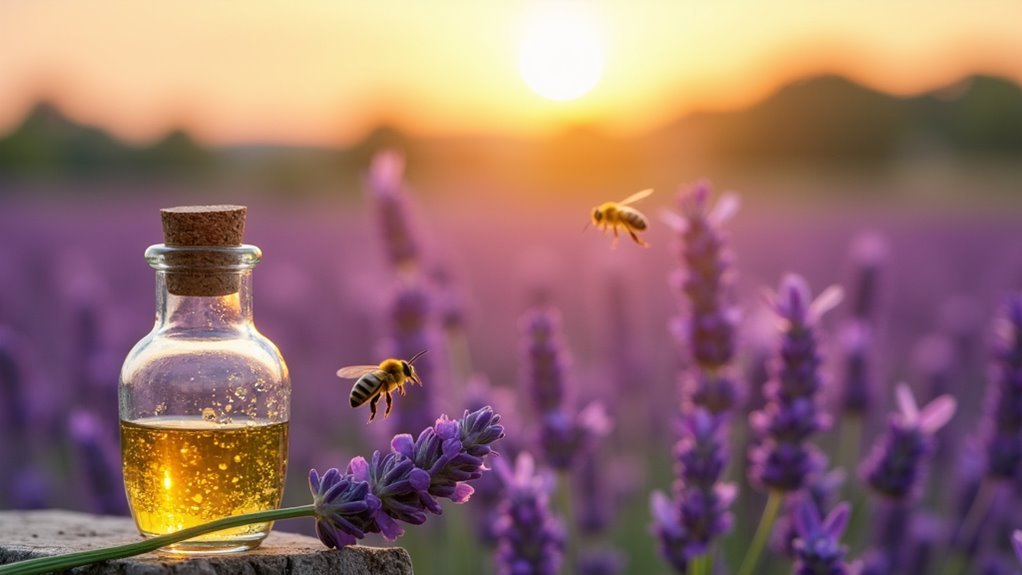
When you’re looking for a safer alternative to chemical-laden bug sprays, lavender essential oil offers an effective solution that protects your family while creating a pleasant environment.
Unlike commercial products filled with harsh chemicals, this natural insect repellent provides proven protection against adult mosquitoes without compromising your health.
This chemical-free alternative delivers effective mosquito protection while keeping your family’s health and safety as the top priority.
You’ll appreciate lavender oil’s family-friendly nature, as it’s completely safe around young children and pregnant individuals.
The calming aroma enhances your outdoor experience while effectively deterring pests, making it far more pleasant than traditional bug sprays with their overwhelming chemical odors.
Creating DIY repellents with essential oils allows you to customize formulations for your specific needs while saving money.
You’re choosing a natural solution that delivers both protection and aromatherapy benefits.
Understanding Lavender Oil’s Effectiveness Against Mosquitoes
While lavender oil offers numerous advantages as a natural pest deterrent, understanding its actual performance against mosquitoes helps you set realistic expectations for protection.
Research reveals this essential oil’s mixed effectiveness against mosquito populations:
- Moderate repellent action – Higher concentrations reduce mosquito landings but don’t eliminate biting entirely.
- Limited coverage – Provides less extensive protection compared to commercial bug spray formulations.
- Pleasant user experience – The appealing aroma makes it a preferred choice for natural-minded individuals.
- Supplementary protection – Works best when combined with other pest control methods rather than standalone use.
You’ll find lavender oil most effective as part of a broader mosquito management strategy.
While it demonstrates measurable repellent properties against adult mosquitoes, relying solely on this essential oil may leave gaps in your protection when extensive coverage is essential.
Essential Oils That Complement Lavender for Enhanced Protection
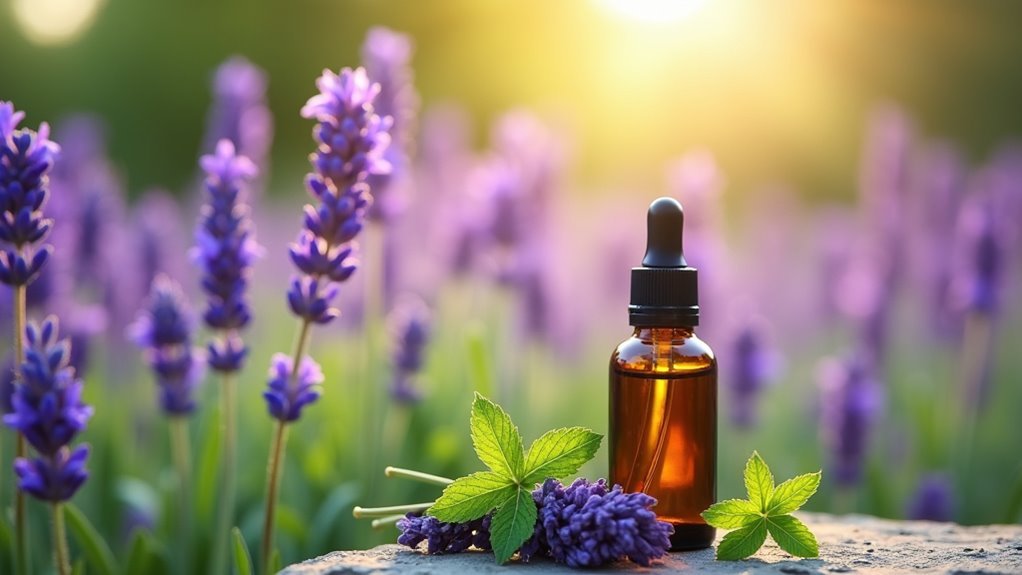
You can considerably boost lavender oil’s pest-repelling power by combining it with other complementary essential oils.
Citronella and lemongrass oils work exceptionally well with lavender, as they’re both proven mosquito deterrents that enhance the overall effectiveness of your homemade repellent.
Rosemary and geranium oil blends create another potent combination, offering you a synergistic approach that targets various pests while maintaining a pleasant aroma.
Citronella and Lemongrass Benefits
Although lavender oil provides excellent pest-repelling properties on its own, combining it with citronella and lemongrass creates a powerhouse blend that greatly boosts your natural defense against insects.
Citronella oil, extracted from lemongrass leaves and stems, brings potent mosquito-repelling capabilities to your DIY blend. When you mix a small amount of Lavender Essential oil with citronella, studies show you’ll reduce mosquito biting by up to 50%.
Here’s why this combination works so effectively:
- Citronella’s strong mosquito-deterring compounds complement lavender’s gentle repelling action.
- Lemongrass contains geraniol, which naturally enhances lavender oil’s effectiveness.
- Both oils provide pleasant citrusy scents that improve your outdoor experience.
- The trio creates extensive protection against various insects while remaining eco-friendly.
This natural blend offers superior pest control without harsh chemicals.
Rosemary Geranium Oil Blends
When you’re looking to maximize your natural pest protection, rosemary and geranium oils serve as exceptional companions to lavender essential oil. Rosemary’s proven ability to deter mosquitoes and flies makes it an ideal blending partner, while geranium’s high citronellol content specifically targets mosquitoes with remarkable effectiveness.
| Essential Oil | Primary Active Compound | Target Pests |
|---|---|---|
| Lavender | Linalool | Moths, fleas, mosquitoes |
| Rosemary | Camphor | Mosquitoes, flies, ants |
| Geranium | Citronellol | Mosquitoes, ticks |
You’ll discover that combining these three oils creates a synergistic effect that’s more potent than using any single oil alone. Studies confirm that essential oil blends provide broader spectrum protection against various insects. This customizable approach lets you adjust the scent profile while maximizing your pest-repelling power.
Creating Your Own Rub-On Lavender Repellent
You’ll need to select the right carrier oil as your base, typically choosing between almond or jojoba oil for their skin-friendly properties.
The key lies in achieving proper mixing ratios – combine 2 tablespoons of your chosen carrier oil with 10-20 drops of lavender essential oil for peak effectiveness.
Once you’ve created your blend, you’ll want to master safe application techniques that protect sensitive areas while maximizing pest protection.
Essential Carrier Oil Selection
Four excellent carrier oils stand out when creating your own rub-on lavender repellent: almond, jojoba, argan, and avocado oil.
These carrier oils serve an essential purpose by diluting lavender essential oil while making application smoother and safer on your skin.
When selecting your carrier oil, consider these key benefits:
- Almond oil – Lightweight texture with excellent absorption properties
- Jojoba oil – Closely mimics skin’s natural oils, reducing irritation risk
- Argan oil – Rich in vitamins with moisturizing qualities
- Avocado oil – Deeply nourishing with longer-lasting protection
You’ll combine 2 tablespoons of your chosen carrier oil with 10-20 drops of lavender essential oil.
This ratio guarantees proper dilution while maintaining the repellent’s effectiveness against pests.
Proper Mixing Ratios
Getting the ratio right makes all the difference between an effective repellent and a waste of expensive essential oil.
You’ll want to combine 2 tablespoons of your chosen carrier oil with 10-20 drops of lavender essential oil. This ratio provides ideal dilution while maintaining repellent effectiveness.
Start with fewer drops if you’re sensitive to scents or have delicate skin. You can always add more lavender oil to strengthen the mixture based on your preferences and the pest pressure you’re facing.
Remember to shake the blend thoroughly before each application to guarantee the oils distribute evenly throughout the mixture.
Test the concentration on a small skin patch first, and adjust the lavender drops accordingly for your comfort level and desired protection strength.
Safe Application Techniques
Once you’ve prepared your lavender oil mixture, applying it safely requires attention to both technique and timing.
Before each use, shake the container well to guarantee the essential oil distributes evenly throughout the carrier oil. This step prevents concentrated spots that could irritate your skin.
Follow these application guidelines for best results:
- Apply a small amount to exposed skin areas where insects typically target.
- Avoid sensitive regions like your eyes, mouth, and any open wounds.
- Test on a small skin patch first if you’re trying the repellent for the first time.
- Wash immediately with soap and water if irritation occurs.
You’ll appreciate lavender’s pleasant aroma while enjoying effective, natural protection that’s safe for children and pregnant individuals.
Making a Spray-On Lavender Insect Repellent
Creating your own spray-on lavender insect repellent requires just a few simple ingredients that you likely already have at home.
Mix 1 ½ tablespoons of distilled water, 1 teaspoon of carrier oil, and 1 teaspoon of witch hazel or vodka in a container. Add 15-25 drops of lavender essential oil to provide bug-repelling properties and a pleasant aroma.
Shake the container well before each use to guarantee all ingredients combine properly. When applying, spray the mixture directly onto your skin while carefully avoiding your eyes and mouth.
You can easily adjust these recipe quantities for larger batches while maintaining the same ratios. This homemade repellent offers an effective, natural alternative to commercial insect sprays without harsh chemicals.
Proper Application Methods and Safety Guidelines
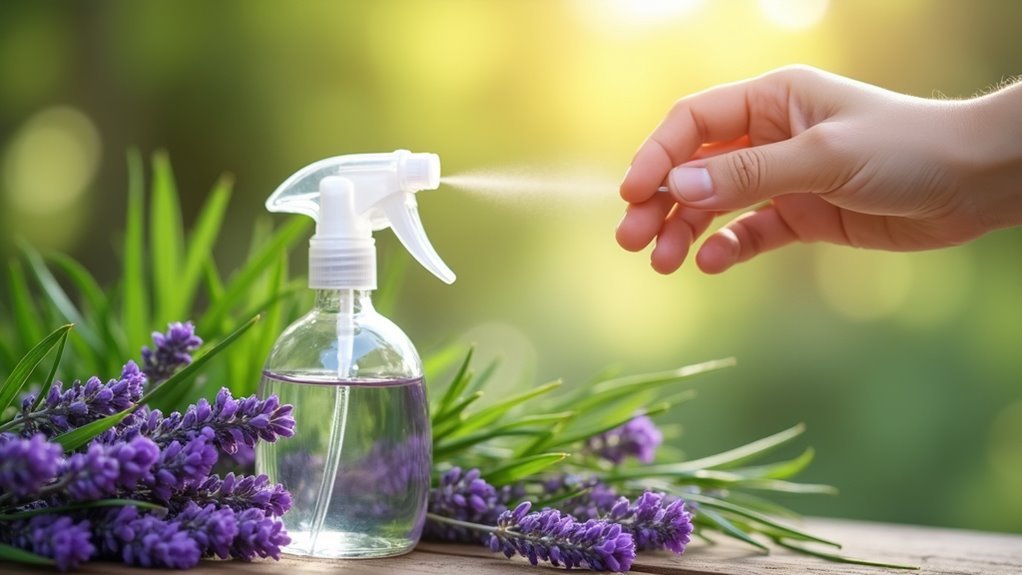
While lavender oil repellents provide natural pest protection, you’ll need to follow proper application techniques to guarantee both effectiveness and safety.
Natural lavender oil repellents require proper application techniques to ensure maximum effectiveness while maintaining complete safety during use.
When applying your homemade repellent, avoid sensitive areas like your eyes and mouth. Use only a small amount of the oil mixture on your skin to prevent overwhelming your senses or causing irritation.
Follow these essential safety guidelines:
- Conduct a patch test by applying a small amount to a discreet skin area and waiting 24 hours.
- Store your repellent in a dark, cool place to maintain potency.
- Shake well before each use to verify ingredients are properly mixed.
- Wash immediately with soap and water if any irritation occurs after application.
These precautions verify effective, safe pest protection.
Real-World Testing of Lavender Oil Concentrations
Although lavender oil shows promise as a natural pest deterrent, real-world testing reveals its limitations compared to commercial alternatives.
When you test lavender oil against mosquitoes, you’ll find it provides some repellent effect, reducing landings and bites in treated areas. However, even with higher concentrations—like mixing 15 drops with sunflower oil—you won’t see greatly improved effectiveness compared to standard dilutions.
You’ll notice that mosquitoes still manage to bite through lavender oil protection, demonstrating its limited capability when used alone. They’ll target untreated skin areas, highlighting the need for thorough coverage.
While lavender oil offers modest repellent action, it doesn’t match commercial insect repellents’ performance, requiring you to evaluate additional protection methods for ideal pest control.
Comparing Lavender Oil Performance to Commercial Repellents
When researchers directly compare lavender oil to commercial insect repellents, the performance gap becomes strikingly apparent.
You’ll find that commercial products deliver complete protection while lavender oil falls short of expectations.
Testing revealed these key differences in effectiveness:
- Complete vs. Partial Protection: Commercial repellents achieved 100% effectiveness while lavender oil allowed 20-30 mosquito bites.
- Coverage Consistency: Mosquitoes targeted untreated skin areas when you use lavender oil, indicating insufficient protection.
- Concentration Impact: Higher lavender oil concentrations didn’t greatly improve results compared to standard formulations.
- Reliability Factor: Commercial repellents provided thorough coverage while lavender oil showed limited pest prevention capabilities.
For ideal mosquito protection, you should rely on commercial insect repellents rather than depending solely on lavender oil’s natural but insufficient repelling properties.
Optimizing Your DIY Lavender Pest Control Strategy
Despite lavender oil’s limitations compared to commercial products, you can still maximize its natural repelling potential through proper formulation and application techniques.
Start by creating a skin-friendly oil blend using 2 tablespoons of carrier oil like almond or jojoba with 10-20 drops of lavender essential oil.
For broader coverage, make a spray combining 1½ tablespoons distilled water, 1 teaspoon carrier oil, 1 teaspoon witch hazel or vodka, and 15-25 drops lavender oil.
Enhance effectiveness by adding complementary essential oils like citronella or lemongrass.
Don’t assume higher concentrations work better—regularly test different formulations to find your ideal balance.
Always shake spray mixtures well before applying to guarantee proper ingredient distribution.
Frequently Asked Questions
What Pests Does Lavender Oil Repel?
You’ll find lavender oil repels mosquitoes most effectively, reducing their landing and biting behavior. It also works against moths, fleas, and certain ant species by disrupting their sensory receptors when applied.
How to Use Lavender Oil as Insect Repellent?
You can make a rub-on repellent by mixing 2 tablespoons carrier oil with 10-20 drops lavender oil, or create a spray using water, carrier oil, witch hazel, and 15-25 drops lavender oil.
What Do You Mix With Lavender Oil to Make a Spray?
You’ll mix lavender oil with distilled water, a carrier oil like almond or jojoba, and witch hazel or vodka. Combine 1½ tablespoons water, 1 teaspoon each carrier oil and witch hazel, plus 15-25 drops lavender oil.
When Should You Not Use Lavender Oil?
You shouldn’t use lavender oil on infants under two, during pregnancy without consulting doctors, with lavender allergies, or with skin conditions like eczema without patch testing first.
In Summary
You’ve discovered that lavender oil offers a natural, effective alternative to harsh chemical repellents. By creating your own blends and experimenting with concentrations, you’ll find the perfect formula for your needs. Remember to reapply regularly and combine lavender with complementary oils for maximum protection. With proper application techniques and consistent use, you’ll successfully keep pests at bay while enjoying the pleasant aroma that lavender provides.



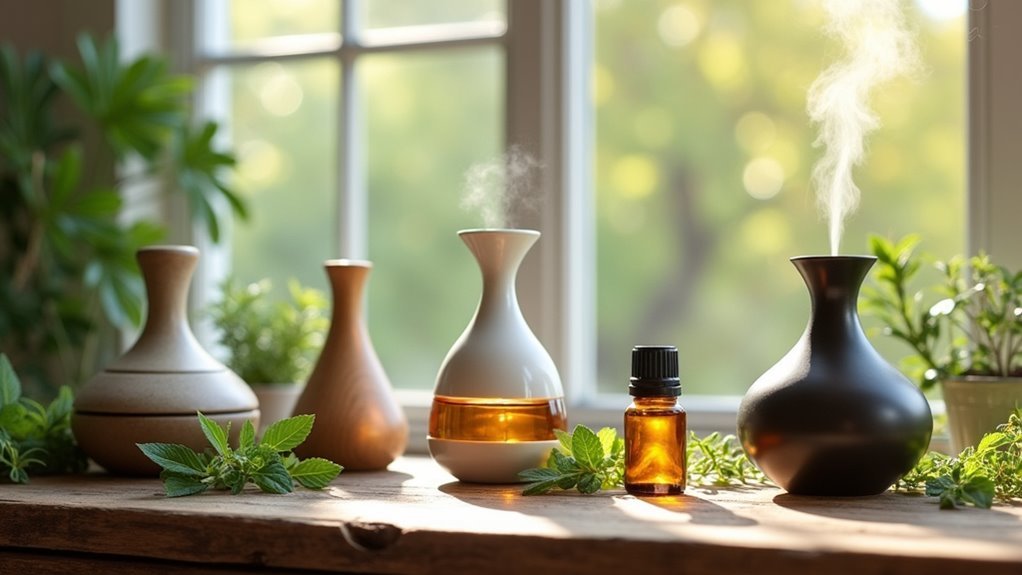
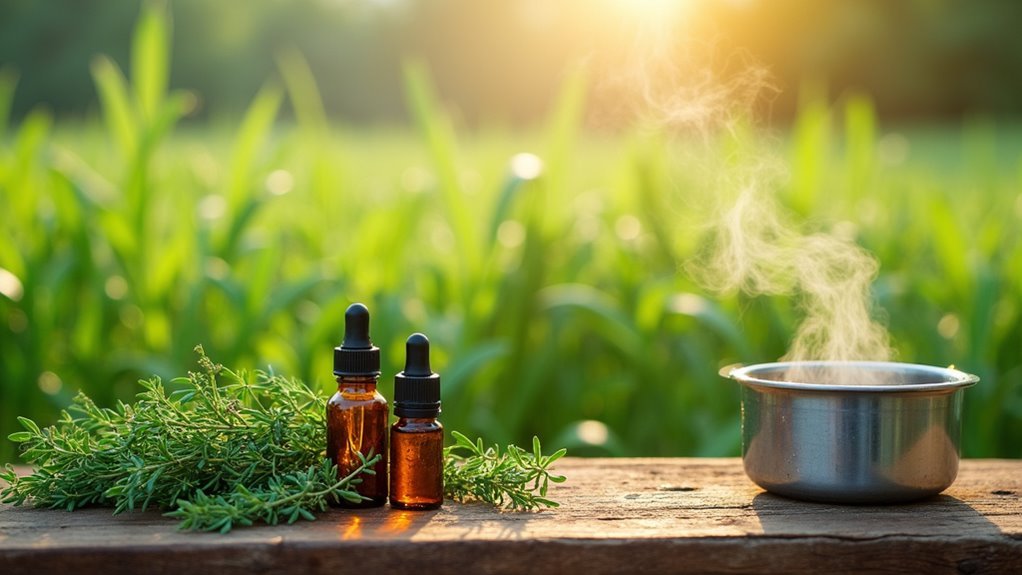
Leave a Reply